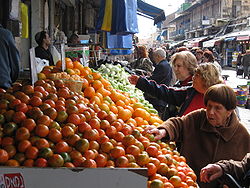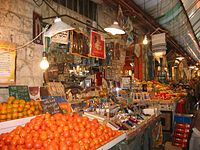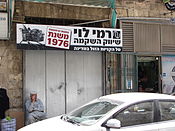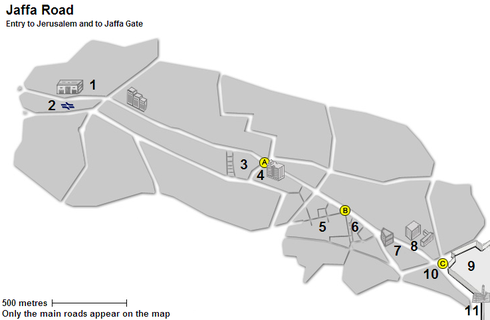- Mahane Yehuda Market
-
Mahane Yehuda Market (Hebrew: שוק מחנה יהודה, Shuk Mahane Yehuda), often referred to as "The Shuk", is an outdoor marketplace in Jerusalem, Israel. Popular with locals and tourists alike, the market's more than 250 vendors[1] sell fresh fruits and vegetables; baked goods; fish, meat and cheeses; nuts, seeds, and spices; wines and liquors; clothing and shoes; housewares, textiles, and Judaica.[2][3]
In and around the market are falafel and shawarma stands, juice bars, cafes, and meat restaurants.[1] The color and bustle of the marketplace is accentuated by vendors who call out their prices to passersby.[1] On Thursdays and Fridays, the marketplace is abuzz with shoppers stocking up for Shabbat.[4]
Contents
Location
Mahane Yehuda market is bounded by Jaffa Road to the north, Agrippas Street to the south, Beit Yaakov Street to the west, and Kiach Street to the east.[5] The market itself has two major streets: Eitz Chaim Street (the covered market) and Mahane Yehuda Street (the open-air market). Bisecting these two streets are smaller streets named for fruits and nuts: Afarsek (Peach) Street, Agas (Pear) Street, Egoz (Walnut) Street, Shaked (Almond) Street, Shezif (Plum) Street, Tapuach (Apple) Street, and Tut (Berry) Street.[3]
History
Jerusalem Light Rail
Red LineLegend

'Heil Ha-Avir (Air Force Street) 

Sayeret Duchifat 

Pisgat Ze'ev Center 

Yekuti'el Adam 

Beit Hanina 

Shuafat 

Es-Sahl 

To depot 

Giv'at Ha-Mivtar 

Ammunition Hill 

Shimon HaTzadik 

Shivtei Israel 

Damascus Gate 

City Hall 

Jaffa - Center 

Ha-Davidka 

Mahane Yehuda 

Ha-Turim 

Central Station 

Kiryat Moshe 

He-'Haluts 

Denia Square 

Yefeh Nof 

Mount Herzl The neighborhood of Mahane Yehuda was established in 1887 with 162 houses. It was founded by three business partners — Johannes Frutiger (a German Protestant and owner of the largest bank in Palestine), Shalom Konstrum, and Joseph Navon — and was named after Navon's brother, Yehuda.[3] It abutted another new neighborhood, Beit Ya'akov, founded in 1885.[6]
At the end of the 19th century, a marketplace was established between the two neighborhoods on an empty lot owned by the Sephardi Valero family;[3] this market was known as Shuk Beit Yaakov (Beit Yaakov Market).[6] Here Arab merchants and fellaheen sold their goods to the residents who lived outside the Old City. As the new neighborhoods outside the Old City grew, the Beit Yaakov Market grew apace with more stalls, tents and pavilions.[6]
Under Ottoman rule, the market expanded haphazardly and sanitary conditions worsened. In the late 1920s, the British Mandate authorities cleared out all the merchants and built permanent stalls and roofing.[3] Afterwards the market began to be known as the Mahane Yehuda Market, after the larger neighborhood.
In the 2000s, major renovations were made to the Mahane Yehuda Market, including infrastructure work, repaving roads and covering some open areas.[3]
Iraqi Market
In 1931 a new section was built to the west of the market by 20 traders, who previously had only temporary wooden stalls in the area. It was later named the Iraqi Market, as many traders of Iraqi Jewish descent acquired shops there.[7] Today the Iraqi Market is located off Mahane Yehuda Street.
Transportation
Several bus lines serve the market at the Agrippas end. The first line of the Jerusalem Light Rail has a station on Jaffa Road, right near the market.
Notable residents and trades
The first generation of the Banai family of actors and musicians originally lived at 1 HaAgas Street at the southern end of the market. In 2000 the Jerusalem municipality renamed this street as Eliyahu Yaakov Banai Street after the family's patriarch. Ehud Banai, a family member, wrote a song entitled "One HaAgas Street", which describes the life and atmosphere at the family home.[8]
In 1976 Rami Levi opened his first store on Hashikma Street, one of the streets in the Mahane Yehuda district, selling food products to consumers at wholesale prices. Today Rami Levi Hashikma Marketing (TASE:RMLI) is the third largest food retailer in Israel.[9]
In the mid-2000s, Ethiopian food sellers began to appear in and around the market.[10][11]
Long known for bargain prices on everything from vegetables to clothing, the market has upgraded its offerings in recent years. Three new designer clothing stores opened in 2007;[12] there are also new bistros, gourmet delicatessans, an Italian coffee house, an imported kitchenware shop, and sellers of boutique wines and cheeses.[13][14][2]
Terrorist attacks
Because of its high pedestrian traffic, it was a target for terrorist attacks during the Second Intifada:
- 1997 Mahane Yehuda Market Bombings: On July 30, 1997, 16 people were killed and 178 wounded in two consecutive suicide bombings.[15]
- On November 6, 1998, two terrorists died when their bombs exploded prematurely.[16]
- 2002 Mahane Yehuda Market bombing: On April 12, 2002, a female suicide bomber detonated at the entrance to the market, killing 7 and injuring 104. The Al-Aqsa Martyrs' Brigades claimed responsibility.[17]
References
- ^ a b c Rosenthal, Morris (May 2009). "Mahane Yehuda – The Jerusalem Shuk (Outdoor Market)". Foner Books.com. http://www.fonerbooks.com/guide_30.htm. Retrieved June 17, 2010.
- ^ a b Mitnick, Joshua (February 27, 2008). "Whole Lotta Shuk-ing Going On". The Jewish Week. http://www.thejewishweek.com/special_sections/israel_now/whole_lotta_shuk_ing_going. Retrieved July 3, 2011.
- ^ a b c d e f Browns, Shmuel (September 17, 2009). "Visiting the Mahane Yehuda Open Air Market". israelnationalnews.com. http://www.israelnationalnews.com/News/News.aspx/133492. Retrieved June 17, 2010.
- ^ "Mahane Yehuda". The Jewish Agency for Israel. http://www.jafi.org.il/education/noar/sites/shuk.htm. Retrieved June 17, 2010.
- ^ "Map of Mahane Yehuda Market". Israel Tour Guide. http://israeltours.wordpress.com/2008/05/31/map-mahane-yehuda-market/.
- ^ a b c Rossoff, Dovid (1998). Where Heaven Touches Earth. Guardian Press. ISBN 0-87306-879-3.
- ^ Yonah, Yaffa (Nov 3, 2009), "All Shuk Up: Returning to the Marketplace", PresenTense, http://presentense.org/magazine/all-shuk-up-returning-to-the-marketplace
- ^ "History of the Banai Family on 1 HaAgas Street.", Jerusalem municipality, http://translate.google.com/translate?prev=hp&hl=en&js=y&u=http%3A%2F%2Fwww.jerusalem.muni.il%2Fjer_sys%2Fpicture%2Fatarim%2FToursite_form_atar.asp%3Fsite_id%3D8741%26pic_cat%3D1%26icon_cat%3D5%26york_cat%3D8%26type_id%3D329&sl=iw&tl=en&history_state0=, retrieved November 8, 2009
- ^ "Company description". The Financial Times Ltd.. 2011. http://markets.ft.com/tearsheets/businessProfile.asp?s=RMLI:TLV. Retrieved June 28, 2011.
- ^ Kraft, Dina (February 26, 2006). "Veteran Ethiopian Israeli community divided on Falash Mura’s immigration". Jewish Agency for Israel. http://www.jewishagency.org/JewishAgency/English/About/Press+Room/Jewish+Agency+In+The+News/2006/2/feb26jta.htm. Retrieved July 7, 2010.
- ^ "Ethiopian Spice Shop". ethiopianrestaurant.com. 2006. http://www.ethiopianrestaurant.com/israel/ethiopian_spice_shop.html. Retrieved July 7, 2010.
- ^ Wiessen, Laura (February 22, 2007). "Designs on the Shuk". The Jerusalem Post. http://www.jpost.com/Home/Article.aspx?id=52377. Retrieved June 17, 2010.
- ^ Palti, Michael (October 12, 2005). "Shazif Invades the Shuk: Among the vegetable and meat stalls of Jerusalem's open-air market are a relatively new Italian coffee house, gourmet delicatessen and bistro. Is Mahane Yehuda on its way to becoming a yuppie stronghold?". Haaretz. http://www.haaretz.com/news/shazif-invades-the-shuk-1.171764. Retrieved July 3, 2011.
- ^ Elliman, Wendy (May 25, 2007). "From Cheap to Chic – Jerusalem shuk goes upscale". Israel Press Service. http://www.jweekly.com/article/full/32560/from-cheap-to-chic-jerusalem-shuk-goes-upscale/. Retrieved June 17, 2010.
- ^ "Terrorist Attacks in Israel, 1994–2006". The Israel Project. May 2, 2006. http://www.theisraelproject.org/site/apps/nl/content2.asp?c=hsJPK0PIJpH&b=883997&ct=1218091. Retrieved 2010–06–17.
- ^ "Victims List – Terrorist Attacks Against Israel". israelsmessiah.com. http://www.israelsmessiah.com/israel_today/victims_list_1.htm. Retrieved 2010–06–17.
- ^ "Chronology of Palestinian Suicide Bombings". Facts of Israel.com. http://www.factsofisrael.com/en/palestine-suicidebombs.shtml. Retrieved June 17, 2010.
See also
- Carmel Market
- Economy of Israel
Jaffa Road Places 1. Central Bus Station · 2. Railway station (planned) · 3. Mahane Yehuda Market · 4. Klal Center
5. Ben Yehuda Street · 6. Nahalat Shiva · 7. Generali Building · 8. Safra Square / City Hall · 9. Old City
10. Mamilla · 11. Jaffa Gate / Tower of DavidSquares A. Davidka Square · B. Zion Square · C. Tzahal Square · D. Safra Square Categories:- Neighbourhoods of Jerusalem
- History of Jerusalem
- Food markets
- Markets in Israel
- Economy of Jerusalem
Wikimedia Foundation. 2010.






